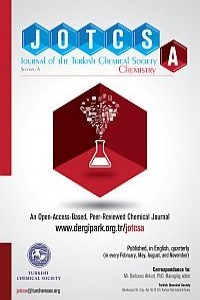Investigation of Photochromic Fluorescence Features and Synthesis of Diarylethene Type Naphthalimide Compounds
The aim of the study was to synthesise novel photo-exchangeable photochromic fluorescence compounds. Starting from N-butyl-4-bromo-3-iodo-1,8-naphthalimide new compounds: 3,4-Bis(3,5-dimethyl-4-pyrazolyl)-N-butyl-1,8-Naphthalimide 6 and 3,4-Bis (1,3,5-trimethyl-4-pyrazolyl)-N-butyl-1,8-Naphthalimide 7 were prepared via two step Suzuki coupling reaction of pyrazolyl boronic acid esters, and characterized by 1H-NMR, 13C-NMR, MS and FTIR. Their photochromic fluorescence properties were investigated. Additionally, a solvent effect on the fluorescence properties of 6 and 7 was investigated. Increase of organic solvent polarity results in a red shift (to longer wavelengths) of the fluorescence emissions.
Keywords:
Solvent effect, Naphthalimide Diarylethene, Fluorescence switch,
___
- 1. Cipolloni M, Ortica F, Bougdid L, Moustrou C, Mazzucato U and Favaro G. New Thermally Irreversible and Fluorescent Photochromic Diarylethenes. J. Phys. Chem. A. 2008; 112:4765–71.
- 2. Yamaguchi H, Matsuda K and Irie M. Excited-State Behavior of a Fluorescent and Photochromic Diarylethene on Silver Nano particles. J. Phys. Chem. C. 2007; 111: 3853-62.
- 3. Liu HH and Chen Y. The Photochromism and Fluorescence of Diarylethenes with a Imidazole Bridge Unit: A Strategy for the Design of Turn-on Fluorescent Diarylethene System. J. Phys. Chem. A. 2009; 113:5550–53.
- 4. Gundogdu L, Kose M, Takeuchi S, Yokoyama Y, Orhan E. Synthesis, photochromic and fluorescence properties of new bithiazole-containing diarylethenes as cation sensors. Journal of Luminescence. 2018; 203:568-75.
- 5. Orhan E, Köse M, Yazan T. The synthesis of new 3,4-(bisaryl)-1,8-naphthalimide and 2,3-(bisaryl)-7HH-benzimidazo[2,1-a]benzo[d]isoquinolin-7-one compounds and an investigation of their photochromic properties. Turk J Chem. 2018; 42:1086–94.
- 6. Orhan E, Gundogdu L, Kose M, Yokoyama Y. Synthesis and photochromic properties of 4,5-bisaryl-3(2H)-pyridazinones. Journal of Photochemistry and Photobiology A: Chemistry. 2016; 314:164–70.
- 7. Yagi K, Soong CF and Irie M. Synthesis of Fluorescent Diarylethenes Having a 2,4,5-Triphenylimidazole Chromophore. J. Org. Chem. 2001; 66:5419-23.
- 8. Fukaminato T, Sasaki T, Kawai T, Tamai N and Irie M. Digital Photoswitching of Fluorescence Based on the Photochromism of Diarylethene Derivatives at a Single- Molecule Level. J. Am. Chem. Soc. 2004; 126(45):14843-49.
- 9. Uchida K, Nakamura S, Irie M. Photochromism of dinaphthylethene derivatives. Stability of the closed-ring forms. Res. Chem. Intermed. 1995; 21(8-9):861-76.
- 10. Milder MTW, Herek JL, Areephong J, Feringa BL and Browne WR. Tunable Aggregationand Luminescence of Bis(diarylethene)sexithiophenes. J. Phys. Chem. A. 2009; 113:7717–24.
- 11. Nakagawa T, Hasegawa Y and Kawai T. Photoresponsive Europium(III) Complex Based on Photochromic Reaction. J. Phys. Chem. A. 2008; 112(23):5096–103.
- 12. Kose M, Orhan E, Suzuki K, Tutar A, Ünlü CS, Yokoyama Y. Preparation and photochromic properties of 2,3-bisarylbenz[f]indenones. Journal of Photochemistry and Photobiology A: Chemistry. 2013; 257:50–53.
- 13. Kose M, Orhan E. Comparison of photochromic properties and thermal stabilities of fulgide, fulgimide, and benzimidazole[1,2-a]pyrrolidine-2-one derivatives. Turk J Chem. 2009; 33:579–88.
- 14. Orhan E. Synthesis of Novel Diarylethenes Bearing Naphthalimide Moiety and Photochromic Fluorescence Behaviors. Journal of the Turkish Chemical Society, Section A: Chemistry. 2017; 4(2):501-16.
- 15. Tsujioka T, Irie M. Electrical functions of photochromic molecules. Journal of Photochemistry and Photobiology C: Photochemistry Reviews. 2010; 11:1-14.
- 16. Irie M. Diarylethenes for Memories and Switches. Chem. Rev. 2000; 100:1685-716.
- 17. Kose M, Orhan E, Buyukgungor O. Synthesis of novel photochromic methyl cyanoacetate-condensed fulgide derivatives. Journal of Photochemistry and Photobiology A: Chemistry. 2007; 188:358–63.
- 18. Kose M, Orhan E. Studies on photochromic benzimidazol[1,2a]pyrrolidin-2-ones from the condensation of 2-methyl-3-benzothienylethylidene-(isopropylidene)succinic anhydride with 1,2-diaminobenzenes. Journal of Photochemistry and Photobiology A: Chemistry. 2006; 177:170–76.
- 19. Lin Q, Xiao S, Li R, Tan R, Wang S, Zhang R. Intermolecular hydrogen bonding- assisted high contrast fluorescent switch in the solid state. Dyes and Pigments. 2015; 114:33-39.
- 20. Kanazawa R, Nakashima T and Kawai T. Photophysical Properties of a Terarylene Photoswitch with a Donor–Acceptor Conjugated Bridging Unit. J. Phys. Chem. A. 2017; 121(8):1638-46.
- 21. Shirinian ZV, Lonshakov DV, Kachala VV, Zavarzin IV, Shimkin AA, Lvov AG, Krayushkin MM. Regio- and chemoselective bromination of 2,3- diarylcyclopent-2-en-1-ones. J. Org. Chem. 2012; 77:8112–23.
- 22. Jiang GY, Wang S, Yuan WF, Zhao Z, Duan AJ, Xu CM, et al. Photo- and protondual- responsive fluorescence switch based on a bisthienylethene-bridged naphthalimide dimer and its application in security data storage. Eur J Org Chem. 2007; 2064-67.
- 23. Pu S, Li H, Liu G, Liu W, Cui S, Fan C. Sythesis and the effects of substitution upon photochromic diarylethenes bearing an isoxazole moiety. Tetrahedron. 2011; 67: 1438-47.
- 24. Meng X, Zhu W, Zhang Q, Feng Y, Tan W and Tian H. Novel Bisthienylethenes Containing Naphthalimide as the Center Ethene Bridge: Photochromism and Solvatochromism for Combined NOR and INHIBIT Logic Gates. J. Phys. Chem. B. 2008; 112:15636–45.
- Başlangıç: 2014
- Yayıncı: Türkiye Kimya Derneği
